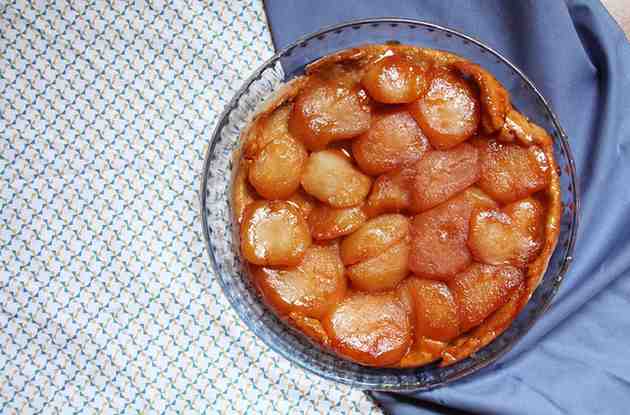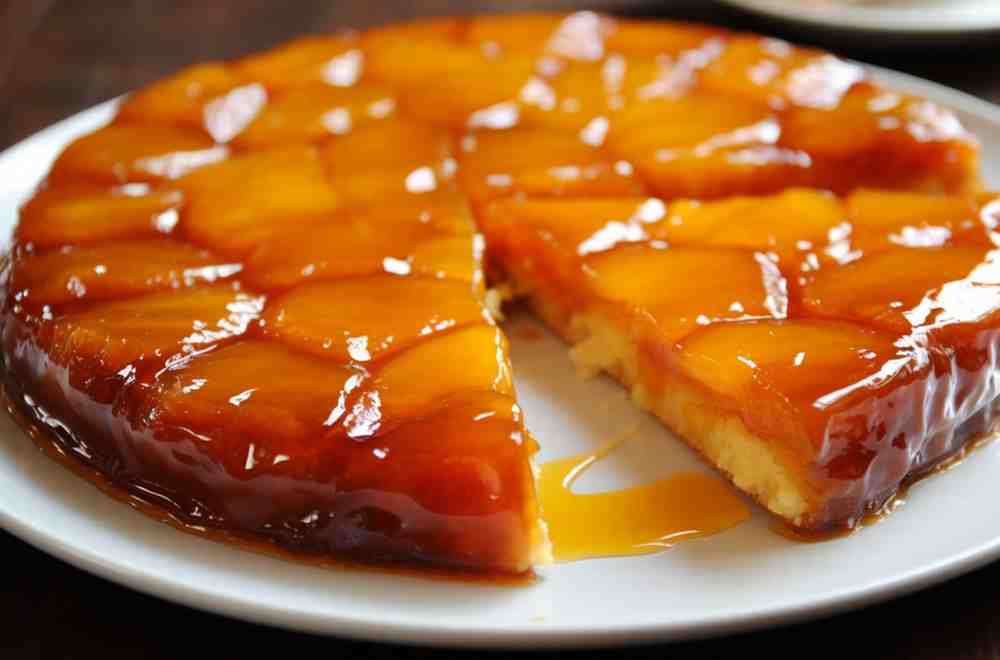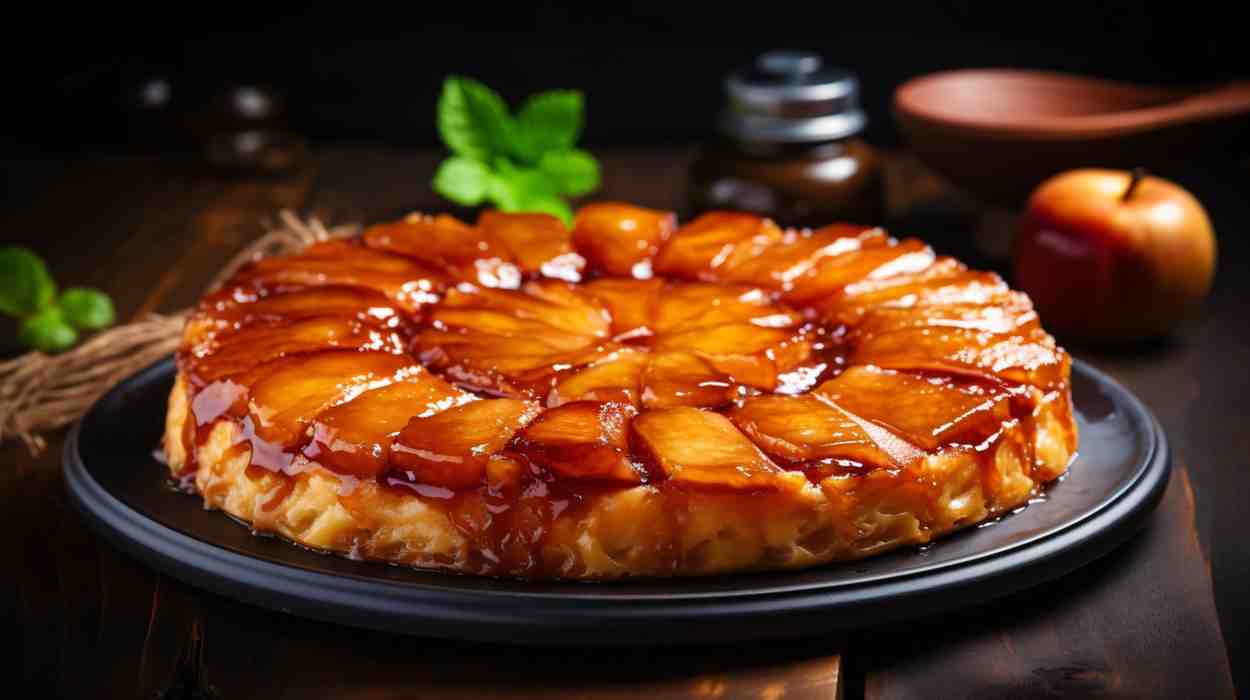Tarte Tatin is a classic French upside-down apple tart that captivates dessert lovers around the world. The dish features caramelized apples baked beneath a flaky puff pastry. Invented by the Tatin sisters in France, this dessert quickly gained international recognition for its simplicity and rich flavor. In this guide, we’ll explore how Tarte Tatin has evolved, its unique ingredients, and how you can recreate this iconic dessert at home.
What is Tarte Tatin?
Tarte Tatin is a caramelized apple tart that stands out due to its upside-down baking method. Traditionally, cooks place apples in a pan with butter and sugar, allowing them to caramelize. Then, they cover the apples with puff pastry and bake the entire tart in the oven. After baking, the tart is flipped over to reveal a beautifully caramelized apple layer. Unlike traditional apple pies, which feature the fruit on top, Tarte Tatin creates a rich blend of caramelized flavors with a buttery crust.
The History of Tarte Tatin
Tarte Tatin originated in France during the late 19th century. The dessert was accidentally created by Stéphanie Tatin and her sister Caroline, who ran the Tatin Hotel. One day, while attempting to make a traditional apple pie, Stéphanie accidentally overcooked the apples in butter and sugar. To save the dish, she covered the apples with pastry and baked the tart upside down.
When Stéphanie flipped the tart out of the pan, she discovered that the caramelized apples, now on top, had formed a deliciously rich glaze. The guests at the hotel loved the dish, and it quickly became a signature recipe. Over time, the Tarte Tatin recipe spread beyond France and gained a loyal following across the globe. Today, variations of this dessert use a variety of fruits, from pears to peaches, while still following the basic principles established by the Tatin sisters.
How to Make the Perfect Tarte Tatin
To make Tarte Tatin, caramelize butter and sugar in an oven-safe pan, then arrange peeled apple halves on top and cook until tender. Cover the apples with puff pastry, tuck in the edges, and bake until golden brown. Let it cool slightly, then invert onto a plate and serve warm.

Step 1: Selecting the Ingredients
Quality ingredients are the foundation of any great dish. Start with the right apples—firm varieties like Granny Smith, Braeburn, or Golden Delicious hold up well during the cooking process without becoming mushy. Their tart flavor also balances the sweetness of the caramel.
Key Ingredients:
- 6–8 firm apples (Granny Smith or similar)
- 1 cup granulated sugar
- ½ cup unsalted butter
- 1 sheet of puff pastry
- Juice of half a lemon
- A pinch of salt (optional)
Note:
Choosing unsalted butter allows you to control the salt levels in the caramel. Lemon juice helps prevent the apples from browning during preparation, keeping them vibrant and fresh. Keep a sheet of ready-made puff pastry on hand, or if you’re adventurous, you can make your own from scratch.
Optional Additions
- Vanilla or cinnamon: These flavors enhance the sweetness and warmth of the dessert.
- Alternative Fruits: Although apples are traditional, variations using pears, plums, or peaches can add an interesting twist.
Required Equipment
To make the perfect Tarte Tatin, you’ll need specific tools to help with caramelizing the apples and flipping the tart.
- Cast Iron Skillet: A cast iron or oven-safe skillet is essential. This type of skillet ensures even heat distribution, allowing the apples to caramelize perfectly while baking.
- Rolling Pin: If you’re making homemade puff pastry, a rolling pin is crucial for rolling the dough to the correct thickness.
- Spatula: Use a large, flat spatula to flip the tart onto a serving plate without damaging the delicate apple layer.
Step 2: Preparing the Apples
Peeling and Slicing
- Peel the apples, making sure to remove all skin for a smooth, polished appearance.
- Cut each apple in half and core them using an apple corer or a sharp knife. You want to create even halves for a uniform look in the final tart.
- After coring, place the apple halves in a bowl and sprinkle them with a small amount of lemon juice. This keeps them from turning brown while you work on the caramel.
Important Tip:
Make sure not to cut the apples too thin. The thicker apple halves will help create the signature domed effect when the tart is inverted, making it visually appealing and keeping the texture firm.
Step 3: Making the Caramel
Melting the Butter
Using an oven-safe, heavy-bottomed skillet (a cast iron pan works best), melt the ½ cup of butter over medium heat. Swirl the pan as it melts to evenly distribute the butter.
Caramelizing the Sugar
Once the butter has fully melted, add the 1 cup of sugar evenly over the butter. Stir gently, allowing the sugar to dissolve gradually. As the sugar heats, it will begin to transform into a golden-brown caramel.
- Keep stirring until the caramel reaches a deep amber color, being careful not to burn it. If it becomes too dark, it can impart a bitter taste.
- If desired, add a pinch of salt at this stage to create a subtle contrast to the sweetness.
Pro Tip: This process requires careful attention. Never walk away from caramel as it cooks, since it can turn from perfect to burnt in a matter of seconds.
Step 4: Arranging the Apples in the Caramel
Placing the Apples
Remove the skillet from the heat. Start arranging the prepared apple halves directly into the hot caramel, cut side facing up. Work from the outside in, placing the apples as close to each other as possible.
- Make sure the apples are tightly packed since they will shrink slightly during the cooking process.
- Any extra slices can be used to fill the gaps in the center. If needed, cut a few apples into quarters to fit smaller spaces.
Tip: Keep in mind that this is the top of your tart when it’s flipped, so arrange the apples as neatly and attractively as possible.
Step 5: Cooking the Apples
Once the apples are arranged, return the skillet to medium heat. Allow the apples to simmer in the caramel for 10–15 minutes. This softens the apples and allows them to soak in the rich caramel flavor.
While the apples cook, use a spoon to baste them with the caramel from time to time, ensuring each piece becomes fully coated.
- Don’t rush this step. The apples should become tender but not fall apart.
Note: Avoid stirring the caramel excessively during this stage to prevent breaking the apples.
Step 6: Preparing the Puff Pastry
Rolling the Pastry
While the apples are cooking, roll out the puff pastry on a lightly floured surface. The pastry should be about 1 inch wider than the diameter of your skillet. This will allow you to tuck the edges of the pastry under the apples.
- If your puff pastry is frozen, make sure to thaw it properly according to package instructions.
Tucking the Pastry
Once the apples are cooked and tender, remove the skillet from heat. Carefully drape the rolled puff pastry over the apples. Tuck the edges of the pastry into the skillet using a spatula or your fingers, ensuring the apples are fully covered.
- Using a fork, poke a few holes in the pastry to allow steam to escape during baking. This helps prevent the pastry from becoming soggy underneath.
Step 7: Baking the Tarte Tatin
Baking Process
Place the skillet in a preheated oven at 375°F (190°C) and bake for about 25–30 minutes, or until the puff pastry turns a golden brown and looks crispy.
- The pastry should puff up as it bakes, creating a light, airy texture that contrasts beautifully with the rich caramel and soft apples.
If the pastry starts browning too quickly, you can cover the tart lightly with aluminum foil to prevent over-browning.

Step 8: Cooling and Inverting the Tart
Cooling Time
After removing the skillet from the oven, let the tart cool slightly for about 5–10 minutes. This allows the caramel to firm up enough so that the tart holds its shape when flipped.
Inverting the Tarte Tatin
Place a large plate or serving platter over the top of the skillet. Using oven mitts (since the pan is still hot), carefully flip the skillet over so that the tart transfers onto the plate, apple-side up.
- You may need to gently shake the skillet to help the tart release. If any apples stick to the pan, simply reposition them on the tart.
Note: Be cautious during this step, as the caramel may still be hot and runny.
Step 9: Serving and Enjoying
Once the tart has cooled slightly, it’s ready to be served. Tarte Tatin is best enjoyed warm, with the caramel still slightly gooey. For an extra indulgence, serve each slice with a dollop of whipped cream or a scoop of vanilla ice cream.
Optional Garnishes:
- Whipped Cream: Adds lightness and balance to the richness of the tart.
- Vanilla Ice Cream: The cold contrast of ice cream against the warm tart is a classic pairing.
- Crème Fraîche: For a tangier option, crème fraîche complements the sweetness beautifully.
Alternative Ways to Prepare Tarte Tatin
The classic Tarte Tatin, with its caramelized apples and buttery puff pastry, is a timeless French dessert. However, for those following specific dietary plans, such as keto, low-carb, or vegan, it may seem challenging to indulge in this rich and decadent treat. Fortunately, with a few clever ingredient swaps, you can still enjoy a delicious version of Tarte Tatin that fits your dietary needs. Let’s explore three popular alternatives that retain the spirit of this dessert while catering to different nutritional requirements.
1. Keto Tarte Tatin: A Low-Carb Delight
For those on a ketogenic diet, which focuses on low-carb, high-fat intake, a traditional Tarte Tatin is not an ideal choice due to the high sugar content in both the caramel and the apples. However, with a few key changes, you can create a keto-friendly version that is equally satisfying.
Key Ingredient Swaps for a Keto Tarte Tatin
- Apples: Replace apples with chayote squash or zucchini. These vegetables have a much lower carbohydrate content than apples but absorb flavors in a similar way, offering a comparable texture when caramelized. Chayote, in particular, has a neutral flavor that works well with keto-friendly sweeteners.
- Sugar: Instead of using traditional sugar, opt for erythritol or monk fruit sweetener. These keto-approved sweeteners mimic the taste of sugar but with virtually no carbs or impact on blood sugar levels. Erythritol caramelizes well, which makes it an ideal choice for replicating the caramel in a traditional Tarte Tatin.
- Pastry: Puff pastry is typically high in carbs, so instead, you can make a keto-friendly crust using a blend of almond flour and coconut flour, bound together with butter or cream cheese. This combination creates a rich, buttery crust that complements the caramelized filling without spiking your carbohydrate intake.
Baking Tips for a Keto Version
- Pre-cook the chayote squash or zucchini to ensure they become tender during the caramelization process. Chayote is firmer and may require a bit more time to soften compared to apples.
- When using keto-friendly sweeteners like erythritol, keep an eye on the caramel, as they behave slightly differently from traditional sugar. The caramelization process may take longer but will still yield that rich, golden hue.
2. Low-Carb Tarte Tatin: Reducing Carbs Without Losing Flavor
A low-carb diet allows for a slightly higher carbohydrate intake than keto but still aims to minimize refined sugars and processed carbohydrates. With a few modifications, you can enjoy a delicious, lower-carb Tarte Tatin while keeping the flavor intact.
Lower-Carb Ingredient Alternatives
- Apples: While apples can still be used in moderation, you can reduce the overall carb count by substituting half the apples with lower-carb fruits like berries (e.g., blackberries or raspberries). These fruits have a lower glycemic index and offer a tartness that pairs well with caramel.
- Sugar Alternatives: Instead of using traditional sugar, opt for xylitol or Stevia. Xylitol is a popular sugar alcohol that has fewer carbs than sugar but still provides the sweetness needed for caramelization. It works similarly to sugar in many baking recipes, making it an excellent choice for a low-carb version.
- Crust: To cut down on carbs from the puff pastry, you can use a flaxseed crust or a coconut flour-based crust. These alternatives still give you a satisfying base for the tart but with significantly fewer carbohydrates.
Adjusting the Recipe for a Low-Carb Lifestyle
- When caramelizing the fruits, you can use a combination of butter and xylitol for a low-carb caramel. Cook the mixture until it turns golden brown and has a syrup-like consistency.
- If you still want to use apples in your recipe, select varieties that are naturally lower in sugar, such as Granny Smith or Braeburn. Combining these with lower-carb fruits or vegetables helps reduce the overall carb content while still maintaining a balanced flavor profile.
3. Vegan Tarte Tatin: A Plant-Based Twist
For those following a vegan diet, creating a Tarte Tatin without butter, eggs, or dairy might seem challenging, but it’s entirely possible with the right substitutions. A vegan Tarte Tatin can be just as delicious, and it’s a fantastic dessert for those who prefer plant-based eating.
Vegan Ingredient Swaps
- Butter: Replace traditional butter with vegan butter or coconut oil. Vegan butter, made from plant oils, works just as well in caramelizing the sugar and gives the tart a rich, buttery flavor. Coconut oil is another great alternative, although it will impart a slight coconut taste to the dish.
- Sugar: Most sugars are naturally vegan, but to ensure your caramel is fully plant-based, use organic cane sugar, as some refined sugars may be processed with bone char. Organic cane sugar will caramelize just like traditional sugar and gives the same deep, amber color.
- Puff Pastry: Many store-bought puff pastries are made with butter, but you can find vegan puff pastry in health food stores or make your own using vegan margarine. Alternatively, use a phyllo dough made with olive oil for a lighter, crispy version of the tart.
Crafting the Perfect Vegan Tarte Tatin
- The key to a good vegan Tarte Tatin lies in ensuring the caramel is rich and thick enough to coat the apples. Start by melting your vegan butter or coconut oil and mixing it with sugar over low heat until a deep caramel forms.
- Arrange your apples in the caramel, and then cover them with vegan puff pastry or phyllo dough. Bake the tart until the dough is golden and crispy, and then let it rest before inverting it onto a serving plate.

